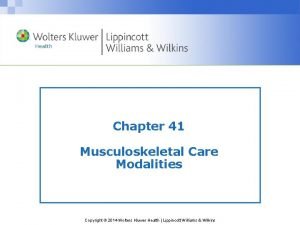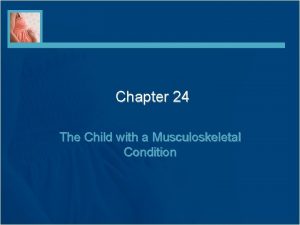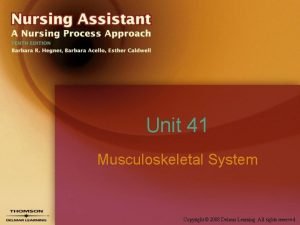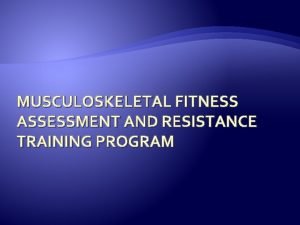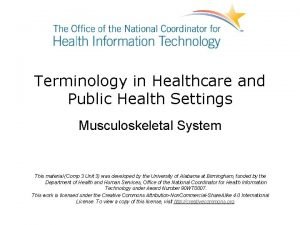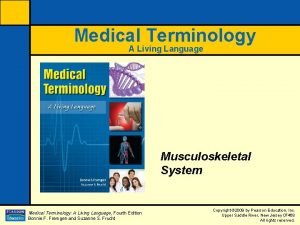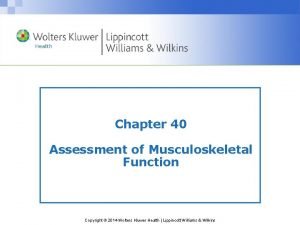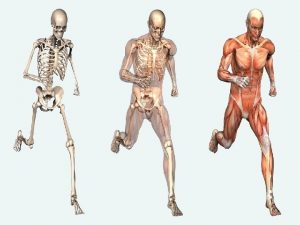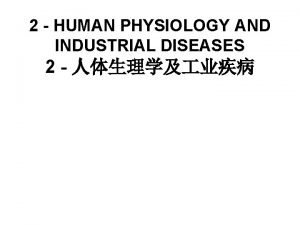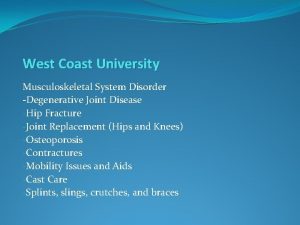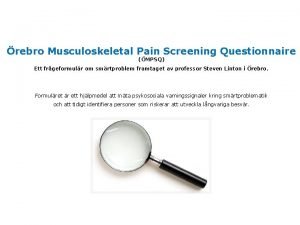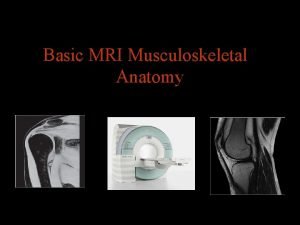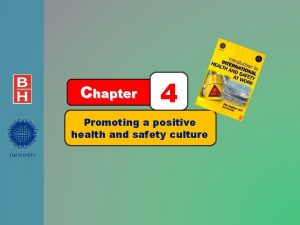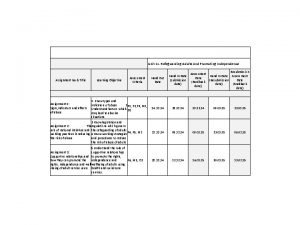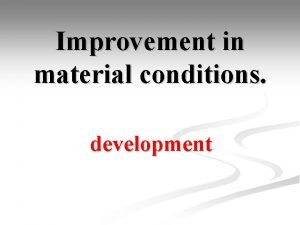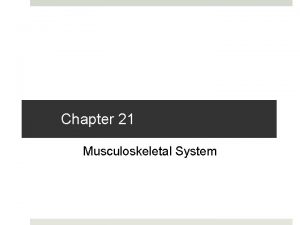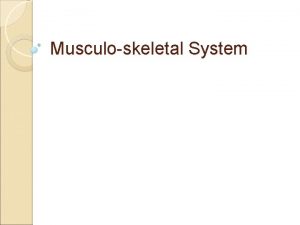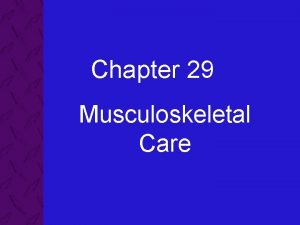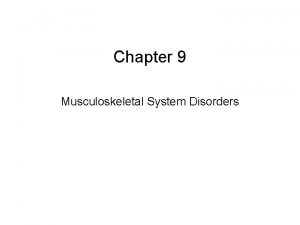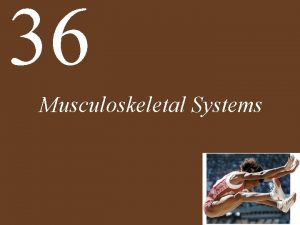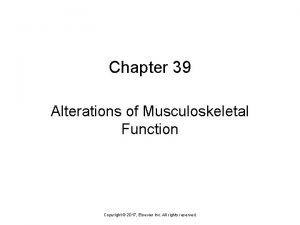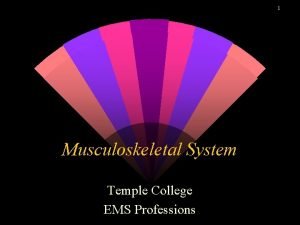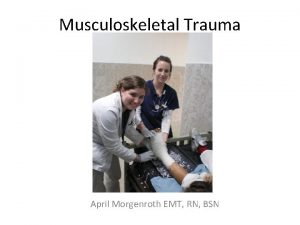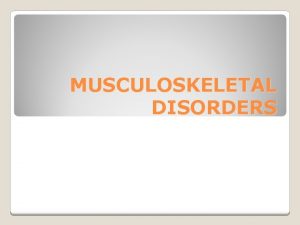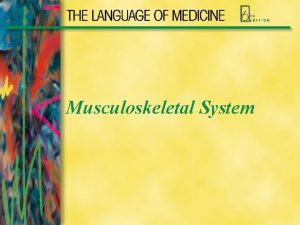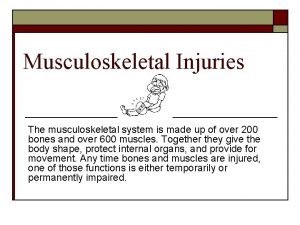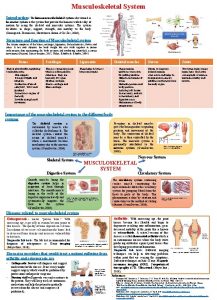Chapter 39 Promoting Musculoskeletal Function Copyright 2018 2014



























































- Slides: 59

Chapter 39 Promoting Musculoskeletal Function Copyright © 2018, 2014, 2009 by Saunders, an imprint of Elsevier Inc. All rights reserved.

Lesson 39. 1 Overview of Immobilization Problems Theory 1) Discuss the effects of inactivity on respiratory exchange and airway clearance. 2) Describe appropriate care of a cast as it dries. 3) Verbalize the differences among an airfluidized bed, low air-loss bed, and continuous lateral rotation bed, listing the reasons for their use. 4) Name at least four pressure relief devices that help prevent skin injury in immobile patients. Copyright © 2018, 2014, 2009 by Saunders, an imprint of Elsevier Inc. All rights reserved.

Lesson 39. 1 Overview of Immobilization Problems Clinical Practice 1) Devise a plan of care for meeting the psychosocial needs of the alert, immobile patient. 2) Correctly care for the patient undergoing skin traction. 3) Use lift sheets and roller or slide devices to move immobilized patients. Copyright © 2018, 2014, 2009 by Saunders, an imprint of Elsevier Inc. All rights reserved.

Immobilization Bed rest may be required when patients are recovering from a variety of conditions Stroke, trauma Ø Neuromuscular disorder Ø Chronic debilitating illness Ø Complications caused by immobilization Pressure injuries, pneumonia Ø Bone loss Ø Loss of function in the immobilized part Ø Copyright © 2018, 2014, 2009 by Saunders, an imprint of Elsevier Inc. All rights reserved.

Systemic Problems/Effects of Immobilization Cardiovascular system Ø Effect • Venous stasis, increased cardiac workload, blood pressure alterations Ø Problems/complications • Thrombus formation • Thrombophlebitis • Pulmonary embolus • Orthostatic hypotension • Increased pulse rate Copyright © 2018, 2014, 2009 by Saunders, an imprint of Elsevier Inc. All rights reserved.

Systemic Problems/Effects of Immobilization (cont’d) Respiratory system Ø Effect • Stasis of secretions, decreased elastic recoil, decreased vital capacity Ø Problems/complications • Hypostatic pneumonia • Bacterial pneumonia • Atelectasis • Decreased gas exchange Copyright © 2018, 2014, 2009 by Saunders, an imprint of Elsevier Inc. All rights reserved.

Systemic Problems/Effects of Immobilization (cont’d) Gastrointestinal (GI) tract Ø Effect • Anorexia, metabolic change to catabolism and negative nitrogen balance, decreased peristalsis Ø Problems/complications • Weight loss • Protein deficiency • Abdominal distention • Constipation Copyright © 2018, 2014, 2009 by Saunders, an imprint of Elsevier Inc. All rights reserved.

Systemic Problems/Effects of Immobilization (cont’d) Musculoskeletal system Ø Effect • Decreased muscle mass and muscle tension, shortening of muscle, loss of calcium from the bone matrix, decrease in bone weight Copyright © 2018, 2014, 2009 by Saunders, an imprint of Elsevier Inc. All rights reserved.

Systemic Problems/Effects of Immobilization (cont’d) Problems/complications Fibrosis of connective tissue Ø Atrophy Ø Weakness Ø Joint contracture Ø Osteoporosis, bone pain Ø Copyright © 2018, 2014, 2009 by Saunders, an imprint of Elsevier Inc. All rights reserved.

Systemic Problems/Effects of Immobilization (cont’d) Urinary system Effect • Stasis of urine, urinary tract infection, renal stones Ø Problems/complications • Precipitation of calcium salts • Frequency of urination • Dysuria Ø Copyright © 2018, 2014, 2009 by Saunders, an imprint of Elsevier Inc. All rights reserved.

Systemic Problems/Effects of Immobilization (cont’d) Skin Ø Effect • Decreased circulation from pressure, ischemia, and necrosis of tissue Ø Problems/complications • Skin breakdown • Pressure ulcers Copyright © 2018, 2014, 2009 by Saunders, an imprint of Elsevier Inc. All rights reserved.

Systemic Problems/Effects of Immobilization (cont’d) Brain/psychological Ø Effect • Decreased mental activity, decreased sensory input, decreased socialization, decreased independence Ø Problems/complications • Disorientation, confusion • Boredom, anxiety • Depression, loneliness Copyright © 2018, 2014, 2009 by Saunders, an imprint of Elsevier Inc. All rights reserved.

Preventing Physical Complications of Immobilization Encourage increasing fluid intake to 3 L/day Encourage adequate nutritional intake Encourage increased fiber in diet Administer stool softeners and laxatives (as ordered) Encourage passive/active ROM exercises Encourage isometric exercises Turn every 2 hours Keep skin clean and dry, use pressure-relief devices Copyright © 2018, 2014, 2009 by Saunders, an imprint of Elsevier Inc. All rights reserved.

Preventing Physical Complications of Immobilization (cont’d) For children, diversionary activities such as games, movies, story reading For adults Television, reading, crafts Ø Crossword puzzles Ø Frequent visitors Ø Nonalert and comatose patients may also need support Copyright © 2018, 2014, 2009 by Saunders, an imprint of Elsevier Inc. All rights reserved.

Types of Immobilization Splints Protect injured parts by immobilizing them Ø May be used as first aid before cast application Ø Types available • Molded splints, immobilizers, inflatable splints, cervical Ø collars, traction splints Inflatable splints may be used to control bleeding; they should be inflated until they can be indented 1/2 inch by fingertips Immobilizers are made of cloth, foam, and Velcro Copyright © 2018, 2014, 2009 by Saunders, an imprint of Elsevier Inc. All rights reserved.

Figure 39 -1: Patient with a leg brace or splint Copyright © 2018, 2014, 2009 by Saunders, an imprint of Elsevier Inc. All rights reserved.

Figure 39 -2: Wrist and forearm splint Copyright © 2018, 2014, 2009 by Saunders, an imprint of Elsevier Inc. All rights reserved.

Types of Immobilization (cont’d) Traction A pulling force used to maintain body alignment, maintain fracture alignment, and relieve pain and muscle spasm Ø Can be skin traction or skeletal traction • Patients in traction should have an overhead frame Ø and trapeze bar • Weights should swing freely without touching bed or floor Copyright © 2018, 2014, 2009 by Saunders, an imprint of Elsevier Inc. All rights reserved.

Traction Skin traction Uses Velcro boots, belts, halters, and slings Ø Applied snugly to the skin • Main purpose is to decrease spasm accompanying Ø fractures • Weight is generally limited to 5 to 10 lb • Complaints of skin pain must be reported Copyright © 2018, 2014, 2009 by Saunders, an imprint of Elsevier Inc. All rights reserved.

Traction (cont’d) Skeletal traction Requires surgical placement of pins, tongs, screws, or wires anchored to the bone Ø Can support more weight than skin traction • Nurse is responsible for maintaining correct weight, Ø alignment, and balance • Clear fluid drainage around pins is expected • Any sign of infection must be reported immediately • Circulation checks are performed every hour for the first 24 hours, then every 4 hours thereafter Copyright © 2018, 2014, 2009 by Saunders, an imprint of Elsevier Inc. All rights reserved.

Types of Immobilization (cont’d) Cast Ø Used to immobilize an extremity following a fracture or orthopedic procedure • Skin is protected by a layer of stockinette, followed by a layer of padding • Cast is then applied (can be plaster or fiberglass) • Cast must be protected during drying to prevent dents and uneven pressure, which can cause circulatory impairment and pressure injuries Copyright © 2018, 2014, 2009 by Saunders, an imprint of Elsevier Inc. All rights reserved.

Figure 39 -4: Hip spica cast Copyright © 2018, 2014, 2009 by Saunders, an imprint of Elsevier Inc. All rights reserved.

Cast When handling a cast, use the palms of the hands and the flat part of the fingers Swelling is common and, if left uncontrolled, can cause circulatory impairment and pressure injury Cast edges should be padded Tight cast may be bivalved Bars on hip spica cast should not be used for lifting or turning Copyright © 2018, 2014, 2009 by Saunders, an imprint of Elsevier Inc. All rights reserved.

Types of Immobilization (cont’d) External fixators Ø Pins, screws, or tongs inserted through one or more bones to stabilize fragments during healing • Metal inserts are attached to an external frame • Fixators allow patient to be more active • Device needs to be checked for stability every 4 hours • Pin care is required to prevent infection Copyright © 2018, 2014, 2009 by Saunders, an imprint of Elsevier Inc. All rights reserved.

Figure 39 -5: An external fixator holding fractured bones in place Copyright © 2018, 2014, 2009 by Saunders, an imprint of Elsevier Inc. All rights reserved.

Devices Used to Prevent Problems of Immobility Specialty beds Air-fluidized beds Ø Low air-loss beds Ø Tiny silicone beads contained within the bed under a flexible, air-permeable filter sheet Achieved by distributing air through multiple cushions connected in a series Continuous lateral-rotation beds Ø Bed turns in an arc up to 80 degrees and can be set to pause on either side for up to 30 minutes Copyright © 2018, 2014, 2009 by Saunders, an imprint of Elsevier Inc. All rights reserved.

Figure 39 -6: Clinitron-Elexis airfluidized therapy unit Copyright © 2018, 2014, 2009 by Saunders, an imprint of Elsevier Inc. All rights reserved.

Figure 39 -7: Roto-Rest Delta continuous lateral rotation kinetic therapy bed Copyright © 2018, 2014, 2009 by Saunders, an imprint of Elsevier Inc. All rights reserved.

Devices Used to Prevent Problems of Immobility (cont’d) Pressure-relief devices Ø Aid in reducing skin trauma from pressure for patients in standard hospital beds • Foam and gel pads • Sheepskin pads • Heel and elbow protectors • Pulsating air pads • Water mattresses that lie on top of the regular mattress Copyright © 2018, 2014, 2009 by Saunders, an imprint of Elsevier Inc. All rights reserved.

Figure 39 -8: Alternating air mattress pad Copyright © 2018, 2014, 2009 by Saunders, an imprint of Elsevier Inc. All rights reserved.

Figure 39 -9: Heel protector helps prevent skin breakdown Copyright © 2018, 2014, 2009 by Saunders, an imprint of Elsevier Inc. All rights reserved.

Devices Used to Prevent Problems of Immobility (cont’d) Continuous passive motion machine Often ordered to restore joint function after orthopedic surgery to replace a joint Ø Used to exercise the extremity and joint, thus preventing contracture, muscle atrophy, venous stasis, and thrombus formation Ø Copyright © 2018, 2014, 2009 by Saunders, an imprint of Elsevier Inc. All rights reserved.

Figure 39 -10: Continuous passive motion machine for the knee joint Copyright © 2018, 2014, 2009 by Saunders, an imprint of Elsevier Inc. All rights reserved.

Therapeutic Exercise Physical therapy often ordered for patient who is immobilized for an extended period of time Full ROM exercises should be performed either actively or passively several times a day To prevent joint injury while performing passive ROM exercises, support the limb to be exercised above and below the joint Copyright © 2018, 2014, 2009 by Saunders, an imprint of Elsevier Inc. All rights reserved.

Question 1 Sharon’s patient has had restricted movement for a long time. One major complication Sharon’s patient might develop is: 1) 2) 3) 4) hypostatic pneumonia. aspiration pneumonia. paresthesia. generalized weakness. Copyright © 2018, 2014, 2009 by Saunders, an imprint of Elsevier Inc. All rights reserved.

Question 2 Sharon’s patient has a continuous passive motion machine. This machine is used to: 1) 2) 3) 4) turn the patient every 2 hours. have her cough and deep-breathe. provide immobilization to a fractured area. exercise the joint after a joint replacement surgery. Copyright © 2018, 2014, 2009 by Saunders, an imprint of Elsevier Inc. All rights reserved.

Question 3 Sharon is working on an orthopedic floor. How often should she inspect casts for cracks, crumbling, pressure problems, and infections? 1) 2) 3) 4) Every 2 hours Every 4 hours Every 6 hours Every shift Copyright © 2018, 2014, 2009 by Saunders, an imprint of Elsevier Inc. All rights reserved.

Lesson 39. 2 Assisting the Immobilized Patient Theory 5) Describe how to perform a neurovascular assessment on an immobilized extremity. 6) Discuss the use of bandages and slings to immobilize a body part. Copyright © 2018, 2014, 2009 by Saunders, an imprint of Elsevier Inc. All rights reserved.

Lesson 39. 2 Assisting the Immobilized Patient Clinical Practice 4) Teach a patient to properly care for a cast following discharge. 5) Correctly apply an elastic bandage to a stump after an amputation. 6) Transfer a patient using a mechanical lift. 7) Assist a patient with the use of each of the following: walker, crutches, cane, brace, prosthesis, and wheelchair. Copyright © 2018, 2014, 2009 by Saunders, an imprint of Elsevier Inc. All rights reserved.

Assessing the Immobilized Patient Assess for indicators of circulatory impairment Look for signs of respiratory impairment Determine which activities of daily living the immobilized patient can perform Perform a neurovascular assessment for any patient with a cast or traction device Assess for cultural beliefs and customs Assess the pulleys and ropes for proper function and free movement Assess any aids to ambulation for structural problems, fit, and safety Assess patient’s gait to determine stability Copyright © 2018, 2014, 2009 by Saunders, an imprint of Elsevier Inc. All rights reserved.

39 -11: Assess the gait of the patient learning to use a walker Copyright © 2018, 2014, 2009 by Saunders, an imprint of Elsevier Inc. All rights reserved.

Common Nursing Diagnoses Impaired physical mobility r/t hemiparesis or hemiplegia (one-sided weakness/one-sided paralysis) Impaired physical mobility r/t fractured extremity in traction or a cast Ineffective tissue perfusion (circulation of blood through tissue) r/t decreased circulation in the lower extremities Impaired tissue integrity r/t skin disruption Acute pain r/t tissue or bone injury, or muscle spasm Ineffective airway clearance r/t inactivity and bed rest Risk for disuse syndrome Risk for peripheral neurovascular dysfunction r/t fracture and cast application Copyright © 2018, 2014, 2009 by Saunders, an imprint of Elsevier Inc. All rights reserved.

Using Bandages to Support, Apply Pressure, or Immobilize Applying elasticized bandages Elevate and support limb while applying Ø Wrap from distal to proximal; apply even pressure while wrapping Ø Overlap turns equally; smooth out wrinkles Ø Secure the end with safety pin, tape, or clips supplied with bandage Ø Check neurovascular status Ø Remove and rewrap at least twice a day Ø Copyright © 2018, 2014, 2009 by Saunders, an imprint of Elsevier Inc. All rights reserved.

Bandages Used to Support, Apply Pressure, or Immobilize (cont’d) Wrapping techniques Circular turn • Used to anchor the bandage and to terminate the wrap Ø Spiral turn • Used to bandage parts of the body that are uniform in Ø circumference Spiral reverse turn • Used to bandage body parts not uniform in circumference Ø Figure-of-8 turn • Used to bandage and stabilize an elbow, knee, or ankle, Ø or to immobilize and hold a fractured clavicle in position Copyright © 2018, 2014, 2009 by Saunders, an imprint of Elsevier Inc. All rights reserved.

Figure 39 -12 A: Applying an elastic bandage—circular turns Copyright © 2018, 2014, 2009 by Saunders, an imprint of Elsevier Inc. All rights reserved.

Figure 39 -12 B: Applying an elastic bandage—spiral turns Copyright © 2018, 2014, 2009 by Saunders, an imprint of Elsevier Inc. All rights reserved.

Figure 39 -12 C: Applying an elastic bandage—spiral reverse turns Copyright © 2018, 2014, 2009 by Saunders, an imprint of Elsevier Inc. All rights reserved.

Figure 39 -12 D: Applying an elastic bandage—figure-of-8 turns Copyright © 2018, 2014, 2009 by Saunders, an imprint of Elsevier Inc. All rights reserved.

Bandages Used to Support, Apply Pressure, or Immobilize (cont’d) Recurrent turn Ø Thumb spica Ø Used to cover distal parts of the body A variation of the figure-of-8 bandage used to support the thumb in neutral position following a sprain or other injury Sling Ø Holds extremity in an elevated position to avoid edema of the hand, pain and discomfort, and fatigue Copyright © 2018, 2014, 2009 by Saunders, an imprint of Elsevier Inc. All rights reserved.

Figure 39 -12 E: Applying an elastic bandage—recurrent turn bandaging Copyright © 2018, 2014, 2009 by Saunders, an imprint of Elsevier Inc. All rights reserved.

Figure 39 -12 F: Applying an elastic bandage—thumb spica bandaging Copyright © 2018, 2014, 2009 by Saunders, an imprint of Elsevier Inc. All rights reserved.

Figure 39 -13: A triangular bandage sling Copyright © 2018, 2014, 2009 by Saunders, an imprint of Elsevier Inc. All rights reserved.

Using a Mechanical Lift to Transfer Immobile Patients Can be used to move a patient from bed to chair or stretcher and back again Hydraulic pump allows one nurse to lift patient Ø It takes two people to use the lift safely Ø Patient must never be left unattended in the lift Ø Also used to place patients into a tub or whirlpool bath for bathing or hydrotherapy Ø Copyright © 2018, 2014, 2009 by Saunders, an imprint of Elsevier Inc. All rights reserved.

Aids to Mobilization Walkers Ø Crutches Ø Frequently the first mechanical aid used when training an individual to walk following a loss of function May follow the use of a walker or be the first aid to ambulation Canes Ø Most commonly used canes are the standard (onepoint) and the quad (four-point) cane Copyright © 2018, 2014, 2009 by Saunders, an imprint of Elsevier Inc. All rights reserved.

Aids to Mobilization (cont’d) Wheelchairs Ø Used for patients who are not able to ambulate either independently or with aids Braces, splints, and prostheses for stabilization Ø Prostheses are used to replace missing body parts Copyright © 2018, 2014, 2009 by Saunders, an imprint of Elsevier Inc. All rights reserved.

Figure 39 -15: Regular cane (right) and quad cane (left) Copyright © 2018, 2014, 2009 by Saunders, an imprint of Elsevier Inc. All rights reserved.

Aids to Mobilization (cont’d) Rehabilitation Exercise prescription to improve muscle tone, joint flexibility, and/or cardiovascular fitness Ø Parameters for exercise determined by target heart rate during activity that is based on age and condition Ø Copyright © 2018, 2014, 2009 by Saunders, an imprint of Elsevier Inc. All rights reserved.

Question 4 When discharging a patient on crutches, it is imperative that he know there should be how much space between the top of the crutch and the axilla when his hands are gripping the crutches? 1) 2) 3) 4) 4 inches 12 inches Two finger-breadths Four finger-breadths Copyright © 2018, 2014, 2009 by Saunders, an imprint of Elsevier Inc. All rights reserved.

Question 5 Tim’s patient needs a lift to help him get into hydrotherapy. When using a lift, all of the following are true except: 1) 2) 3) 4) one person can safely move a weak patient this way. you should never leave the patient unattended. you should protect the lift with a sheet or bath blanket. if a lift is soiled, you should use a disinfectant solution before using it again. Copyright © 2018, 2014, 2009 by Saunders, an imprint of Elsevier Inc. All rights reserved.
 2014 pearson education inc
2014 pearson education inc Chapter 21 the musculoskeletal system
Chapter 21 the musculoskeletal system Chapter 6 musculoskeletal system diseases and disorders
Chapter 6 musculoskeletal system diseases and disorders Chapter 15 musculoskeletal system practical
Chapter 15 musculoskeletal system practical Chapter 40 musculoskeletal care modalities
Chapter 40 musculoskeletal care modalities Chapter 24 the child with a musculoskeletal condition
Chapter 24 the child with a musculoskeletal condition Copyright © 2018
Copyright © 2018 Copyright © 2018 all rights reserved
Copyright © 2018 all rights reserved Chapter 1 lesson 4 promoting health and wellness
Chapter 1 lesson 4 promoting health and wellness Chapter 1 understanding health and wellness lesson 4
Chapter 1 understanding health and wellness lesson 4 Chapter 7 promoting health and wellness
Chapter 7 promoting health and wellness Chapter 30 promoting bowel elimination
Chapter 30 promoting bowel elimination Chapter 13 distributing and promoting products
Chapter 13 distributing and promoting products Chapter 1 lesson 4 promoting health and wellness
Chapter 1 lesson 4 promoting health and wellness B a f c j e
B a f c j e Types of joint movement
Types of joint movement Unit 41 musculoskeletal system
Unit 41 musculoskeletal system Musculoskeletal system
Musculoskeletal system Soal uas sistem muskuloskeletal
Soal uas sistem muskuloskeletal Muscle loss icd 10
Muscle loss icd 10 Musculoskeletal fitness test
Musculoskeletal fitness test Work related musculoskeletal disorders definition
Work related musculoskeletal disorders definition Musculoskeletal pronounce
Musculoskeletal pronounce Inversion medical terminology
Inversion medical terminology Diseases of the musculoskeletal system
Diseases of the musculoskeletal system Assessment of the musculoskeletal system
Assessment of the musculoskeletal system Assessment of the musculoskeletal system
Assessment of the musculoskeletal system Musculoskeletal system
Musculoskeletal system West coast musculoskeletal
West coast musculoskeletal örebro musculoskeletal pain screening questionnaire
örebro musculoskeletal pain screening questionnaire Microganthia
Microganthia Musculoskeletal integrity
Musculoskeletal integrity Musculoskeletal injury
Musculoskeletal injury Spine pathology
Spine pathology Musculoskeletal
Musculoskeletal Musculoskeletal surgery ayr
Musculoskeletal surgery ayr Cochrane musculoskeletal group
Cochrane musculoskeletal group Musculoskeletal mri anatomy
Musculoskeletal mri anatomy Objective data for musculoskeletal system
Objective data for musculoskeletal system When was the progressive era? *
When was the progressive era? * Promote service arrange decide
Promote service arrange decide Promoting alternative thinking strategies
Promoting alternative thinking strategies Promoting family earthquake preparedness
Promoting family earthquake preparedness Promoting racial literacy in schools
Promoting racial literacy in schools Lesson 4 promoting health and wellness
Lesson 4 promoting health and wellness Leaving cert business philip curry
Leaving cert business philip curry Promoting infant health section 7-2
Promoting infant health section 7-2 Promoting excellence in dementia care
Promoting excellence in dementia care Deontology ethics example
Deontology ethics example Promoting services and educating customers
Promoting services and educating customers Health promoting schools model
Health promoting schools model Rehearsal strategies
Rehearsal strategies Promoting a positive health and safety culture
Promoting a positive health and safety culture Unit 11 safeguarding adults and promoting independence
Unit 11 safeguarding adults and promoting independence National integration and international understanding
National integration and international understanding Institutional support to an entrepreneur on the following
Institutional support to an entrepreneur on the following Health promoting school
Health promoting school Japan's principal asset in promoting development is
Japan's principal asset in promoting development is Discovering computers 2018 ppt download
Discovering computers 2018 ppt download Discovering computers 2018 chapter 1
Discovering computers 2018 chapter 1




